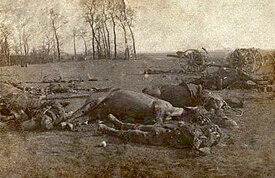Battle of Le Cateau
| Battle of Le Cateau | |||||||
|---|---|---|---|---|---|---|---|
| Part of the Great Retreat on the Western Front of World War I | |||||||
 British dead at the Battle of Le Cateau. |
|||||||
|
|||||||
| Belligerents | |||||||
|
|
|
||||||
| Commanders and leaders | |||||||
|
|
|
||||||
| Units involved | |||||||
|
IV Corps Höhere Kavallerie-Kommando 2 |
II Corps | ||||||
| Strength | |||||||
| 23 infantry battalions 18 cavalry regiments (9 at half strength) 6 divisional cavalry squadrons 162 guns (27 batteries) 84 machine-guns |
40 infantry battalions 12 cavalry regiments 2 divisional cavalry squadrons 246 guns (41 batteries) c. 80 machine-guns |
||||||
| Casualties and losses | |||||||
| 2,900 | 7,812 (700 killed, 2,600 captured) 38 guns |
||||||
The Battle of Le Cateau was fought on 26 August 1914, after the British and French retreated from the Battle of Mons and had set up defensive positions in a fighting withdrawal against the German advance at Le Cateau-Cambrésis.
On the morning of 26 August, the Germans arrived and attacked II Corps (General Sir Horace Smith-Dorrien). Unlike the Battle of Mons, where the majority of casualties inflicted by the British were from rifle fire, Le Cateau was an artilleryman's battle, demonstrating the devastating results which modern quick-firing artillery using shrapnel shells could have on infantry advancing in the open. The British deployed their artillery in the open, about 50–200 metres (55–219 yd) behind their infantry, while the German artillery used indirect fire from concealed positions. With the guns so close to their infantry, the British had unintentionally increased the effectiveness of the German artillery-fire, because shells aimed at the British infantry could just as easily hit the British artillery.
The British 5th Division was positioned on the right flank, on the southern side of the Le Cateau–Cambrai road between Inchy and Le Cateau. The 3rd Division was in the centre, holding the ground between Caudry and Inchy. The 4th Division was on the left flank, on the northern bank of the Warnelle. This was a poor choice of terrain on the part of the British, because the road was sunken in places, providing inadequate long-range firing positions. In fact, in most cases, the Germans could march close up to the British positions, which is what they often did. This was especially true at the weakest point in the British line, the right flank west of Le Cateau, where the Germans simply marched straight down the road from the north, all the way to Le Cateau. The British position was on the forward slope and consequently, casualties were heavy during the withdrawal.
At 03:30, Smith-Dorrien decided to "strike the enemy hard and after he had done so, continue the retreat". The purpose of the operation was unclear to his subordinates. A "hold at all costs" mentality was evident in the 5th Division on the British right flank. The commander of the 2nd Battalion King's Own Yorkshire Light Infantry was given a written order that "There will now be NO retirement for the fighting troops; fill up your trenches, with water, food and ammunition as far as you can." The order was confirmed by a colonel from the II Corps staff, who, upon arriving, repeated it.
...
Wikipedia
